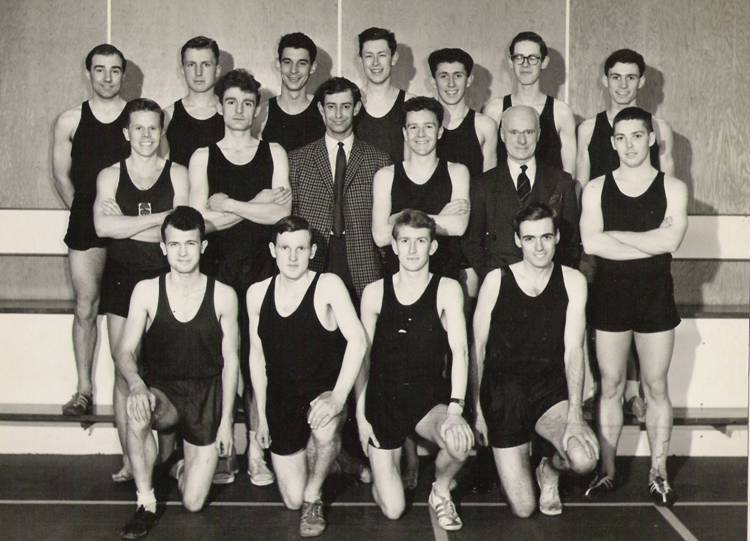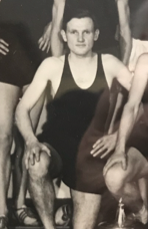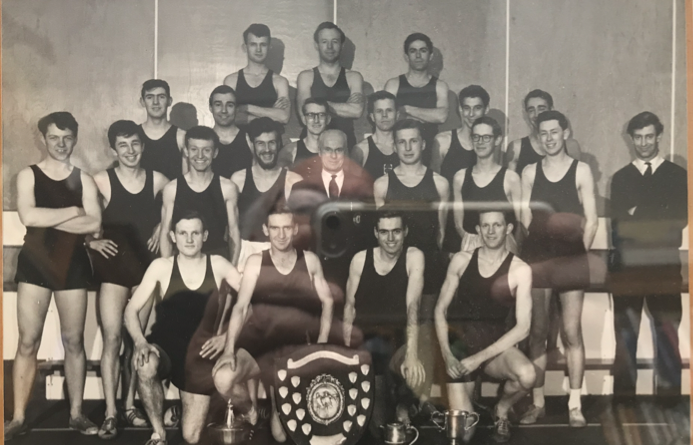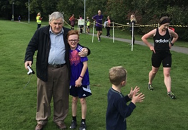Glasgow University Hares and Hounds: Callum Laing second left front row
Callum Laing, the son of a Free Church minister in Alness, started his running career with Inverness Harriers in whose colours he won the North of Scotland Cross-Country Championship in 1960 and 1961. He is best known however for the running that he did as a member of the very good Glasgow University team of the early 1960’s which set records and won medals in events that had not previously been within the grasp of student teams. Individually he won championships and medals at University (Scottish and British) and National (track, road and cross-country) levels as well as representing Scotland in the ICCU Championships. In his centenary history of the SCCU Colin Shields spoke of Callum as “the best distance runner produced by any university to date.” He was certainly a talented athlete who was respected throughout the country.
With a 1936 birth date, Callum was a bit older than the other members of that Hares & Hounds squad. One of his team mates thinks back: “He was a quiet, reserved kind of guy who was good to be around. He was a hard trainer and a hard racer. In the 1962 Edinburgh to Glasgow he took GU from 4th to 1st on the second leg with the fastest time after a fierce tussle with Cambridge “blue” AIC Heron representing Edinburgh Southern Harriers. Also in 1962 he broke his own course record at Aberdeen Uni beating Alistair Wood and Steve Taylor of Aberdeen AAC. At that time he held the course record for 3 of the 4 University courses. His nickname was Methuselah which reflected the fact that he was older than most of us. In 1962 he broke the lap record for the Perth North Inch Relays (Alistair Wood did the same time that day)”
*
He is first mentioned as a University team member in November 1958 when he ran on the second Leg of the Edinburgh to Glasgow Relay. Like many first timers exposed to the pressures and exuberance on the day. it was not his best race: he dropped from 13th to 16th. Nevertheless he ran well enough to be awarded first team colours at the AGM at the end of the year.
On the track in summer 1959 the University distance scene was dominated by Adrian Jackson with Stan Horn being the Glasgow hot-shot for much of the time. There was little opportunity for a new runner on the scene to make an impact but by the end of the year, Laing was ranked nationally for the first time, his best Three Miles time being 14:47.5 which placed him 19th. The North of Scotland District of the SCCU was just getting itself organised and there are few results available from that time but we do know that he won the North of Scotland Senior Cross-Country Championships in 1960 and that he ran in the Scottish National Cross Country Championship where he was fifty second finisher although Inverness had no team competing.
Later that year he was out in the first of the winter championships which was the District Relay Championships on 5th November. This time it was the Midland District Relay where he ran on the first stage for the Glasgow team that was eighth. Then on the third Sunday of the month he ran on the second stage of the prestigious second stage of the Edinburgh to Glasgow Relay. The team was third and Callum was second fastest on the stage being only 5 sec down on internationalist Joe Connolly of Bellahouston Harriers. Athletics Weekly simply said “Glasgow University came up from 12th to 4th thanks to a grand effort of 29:51 by C Laing.” The season continued into 1961 and Callum started the year by winning the Inter-Universities Cross Country match in Aberdeen. He returned a month later to win the North of Scotland CC Championship. He then added the Scottish Universities CC title and on 21st January he was tenth in the Midland championship with the University team third. Unfortunately for some reason the Hares & Hounds had no team in the National Championship but Callum ran and finished 35th.
At the Hares & Hounds AGM in March 1961 captain Douglas Gifford sun the praises of the club but of none more than Callum Laing. What follows is a direct quote from his remarks:
The Captain (Douglas Gifford) began his report by saying that the past year had been one of both remarkable success and failure. The Team Trials had been characterized by Calum Laing’s admirable running. He had been undefeated in inter-University competition, and had also won the North of Scotland Cross Country Championship. The Irish tour had been excellent; the Hares and Hounds had been treated exceptionally well by their hosts. Thirty four runners had taken part in the six-odd mile race in Belfast, which started at King’s Bridge, and went via Newforge Lane, Barnett’s Park and the Tow Path to Strathmillis. Calum Laing was first in 34min 53sec, Douglas Gifford second in 4min 55sec, J. Gray third in 35min 13sec, Stuart Hunter fourth in 35min 26sec and Jim Bogan fifth in 36 min 00 sec. Calum Laing also led his Team home in the race against Trinity College(Dublin). In other inter-University competition St Andrew’s and Aberdeen had been beaten comparatively easily by the Hares and Hounds,but Edinburgh had regained their strength to win the Scottish Universities’ Cross Country Championship.
“IntheEdinburgh-GlasgowRelayeveryonehadruntheirheartsoutandtheTeamhadfinishedthirdtheir best ever position in a time of 3 hr 50 min 24sec.”
Calum Laing had done the second fastest time on the second stage (29min 51sec) and brought the Team up from 13th to fourth place. In the Midland District Relay Championship the Hares and Hounds also came third behind Shettleston and Victoria Park in the Senior event, and this the day after the GUAC Ball too! Calum Laing finished fifth in 14min 04sec. John Gray taking over, dropped two places to do a time of 15min 14sec, but this was made up by Jim Bogan (14min 45sec). Dic kHartley took over and returned a creditable time of 15min 34sec. The SUSF Championship had taken place in perfect weather. Calum Laing and the Aberdeen runner (J. Glennie) were neck and neck at the half way stage, but Calum won by 100 yards in 35min 28sec. Excellent individual performances throughout the season had come from Calum Laing and Dick Hartley (who were both awarded Blues) and from Jim Bogan, J. Gray, G. Hartley and Cameron Shepherd. “
At the AGM at the end of the season he was again awarded first team colours and it was noted that he had been undefeated in University competition in Scotland. He had run in the UAU Championships in England, though, where he had been unplaced.
The winter season over, on 29th April, 1961, the Glasgow University v Edinburgh match for the Appleton Trophy was held at Craiglockhart. The general agreement was that the performance of the meeting was that of Callum Laing in the Three Miles which he won in 14:44.4 which was 14.8 seconds faster than the Universities championship time of 1960. Then on 5th May at the triangular fixture with St Andrews and Queens, Belfast, he again won the Three Miles, this time in 15;01.5. Came 13th May and he took 10.2 seconds from the Glasgow University record when he won the club championship in 14:51.2. The Universities championship was held in Aberdeen on 5th June and Laing, after leading all the way, won the Three Miles in 14:37.2 which was a new meeting record. By the end of the season, Callum Laing was ranked in four events at national level:
Mile 4:22.8 19th; Two Miles: 9:18.0 14th Three Miles: 14:26.0 14th Six Miles: 30:41.8 10th
In season 1961-62, the top Glasgow University men missed the District Relays at Stirling because they had a match at Garscadden, Glasgow, against St Andrews University which they won by 26 points to 56, providing six of the top seven runners. Callum won the individual race by 68 seconds from Judge of St Andrews with Baillie, Hartley, Bogan, Gifford and McPhail in that order competing the team. He then ran on the second stage of the Edinburgh to Glasgow eight man relay race on 18th November and moved up from 15th to 12th This time the team was 8th, Callum was second fastest competitor- 56 seconds down on in-form Scottish internationalist John Linaker who had taken Motherwell up from 13th to second. Callum was faster than Scottish internationalists Joe McGhee (Shettleston), Bertie Irving (Bellahouston) and Bobby Calderwood (VPAAC). In the eyes of Athletics Weekly however, this merited only a brief “C. Laing (29:50) brought Glasgow Un. from 15th to 6th.” The Championships season started with the new year and after winning the Universities Championship, he was , on 20th January, 11th in the Midland District Championship with the team finishing 4th.
In February, 1962, Callum ran in the British Universities Championships at Leeds where he finished second to Ron Hill. He also had probably his best race of all those run over the country while at University. He was third in the National Cross Country Championships at Hamilton Race Course with the team finishing eighth. Colin Shields described the race: Andy Brown started the National as favourite with two former champions Graham Everett and Alastair Wood also in the field of 300 runners. The pace was set by 24 year old agricultural student Callum Laing studying at Glasgow University who was the best distance runner produced by any Scottish University to date. At the two and a half mile marker Jim Alder who had previously competed in the Youth and Junior championship, displayed the great improvement in form that he had made and went into the lead. He held off an attempt by Brown to take the lead at half distance and raced away to win hs first Scottish title by 70 yards from Brown, with Laing taking a surprising but well deserved third place, having already gained second place in the British Universities championships.” This gained him International selection for the ICCU championships at Graves Park in Sheffield where he was 37th and a counting member of the Scottish team. He was also, with this selection, the first member of Inverness Harriers to win international selection. The Captain’s report at the AGM said that “Calum Laing, as always, had been his usual devastating self, winning all the Inter-University races. ” He was also awarded his first team colours as, indeed, he was in virtually every year he competed.
At the start of the track racing in 1962 Fergus Murray of Edinburgh was the man who took the University distance running events by storm and he went on to be a Olympian at the Tokyo Games in 1964. In the Glasgow University championships on 12th May, Laing won both Mile and Three Miles – in the former he took 8.8 seconds from his best championship time with 4:18.1 and in the latter his time was 14:42.3 which took 9.2 seconds from his own championship record. He won the Mile against Aberdeen a week later with team mate Allan Faulds winning the Three. A week later at the District Championships he won the Three Miles as well as the Six Miles – the former in 14:01.5 from Mike Ryan of St Modan’s and the latter in 30:27.1. Came the SAAA Championships and he came away with two medals one for 3rd in the Three Miles (14:25.6) and the first place in the Six. Miles (29:53.8). He competed for Scotland on 30th June at Celtic Park, Belfast, in the Three Miles where he was five seconds and three places behind the winner, Bertie Messitt of Ireland with Scotland’s other representative, Steve Taylor, third. By the end of the season, he was ranked in the same four events as in 1961 : Mile: 4:15.3 12th Two Miles: 9:12.4 8th Three Miles: 14:01.6 4th; Six Miles: 29:53.8 3rd
Then it was into the winter road and cross country season with the first championship relay being the District championships where he was the first leg runner for the University in the race, held on 2/11/62. Fastest team runner, he saw the team finish a good 5th. That was followed two weeks later by the eight stage Edinburgh to Glasgow where he ran on the very difficult six miles of the second stage. He was up to the challenge and moved the team from fourth up to first. The team won the bronze medals for third place – the first medals ever won by a University team in the race. His time was 29:07 – 10 seconds quicker than Heron with Donald Macgregor of St Andrews University the only other runner under 30 minutes. “AW” reported Laing (GU) soon went to the front and got away on the last mile to to hand over 25 yards clear of Heron ((ES) who was 2 min. 17 sec. ahead of Summerhill (Shett.) with Vic. Park. and Aberdeen 4th and 5th.” If we return to the championship races, he was ninth, and second Hares & Hounds man three places behind Allan Faulds, in the West District championship in January in which the team finished second. It was a good winter for Laing and in the National at Hamilton Park, with the team seventh, he was eighth to gain selection for the International Cross-Country Association match. Callum again won selection for the International CCU Championships at San Sebastian where he finished 63rd and was a scoring runner for the national squad.
At the Hares & Hounds AGM in March 1963, the captain, Cameron Shepherd, bean his report :
“by listing the Captain’s (Calum Laing) successes during the season. Calum had also been elected Captain of the Scottish Universities’ Team, and had yet again been unbeaten in any of the inter-’varsity races in which he had participated. He now held three of the four records for the Scottish Universities’ courses,and was winner of his leg in the Edinburgh to Glasgow Relay i n which, for only the second time, the Hares and Hounds came third, in a time of 3hr 48min 35sec. The race had been held over a wind-swept and snow-covered course. Glasgow University’s complete Team was Dick Hartley (27min 38ecs), Calum Laing (29min 07sec), Jim Bogan ( 22min 21sec), Douglas Gifford (30min 14sec), Ray Baillie (28min 50sec), Alan Faulds (34min 33sec), Cameron Shepherd (29min 21sec), and L. Scott (26min 31sec). Calum had finished eighth in both the UAU Race and the Scottish National Cross Country Championship. Finally he was to be congratulated upon winning a place in the Scottish National Team due to compete in the International Cross Country Championship that would be held in San Sebastian.”
On the track in 1963, Callum started with a second place in the Three Miles at the Appleton Trophy meeting behind Martin Craven with Allan Faulds in third on a day of strong winds which, combined with a soft track, made for slow times. On 11th May he again won the University Three Miles in a slow 15:06. The Scottish Universities championships were held in Glasgow on 1st June and the Three Miles was won by Martin Craven from Fergus Murray with Callum Laing in third. By the end of summer, 1963, he was ranked in two events:
1963: Two Miles: 9:28,8 27th Three Miles: 14:26.4 15th
With no Hares & Hounds team in the first 12 of the District Relays in 1963, the first race of consequence was the Edinburgh to Glasgow where Callum was again on the second stage. Again he lifted the club – this time from 11th to 7th for the team that was 6th. He himself was fifth fastest on the stage where although he was behind such as Graham Everett, Fergus Murray, AIC Heron and Mel Edwards he still recorded a faster time than Ian McCafferty, and Craig Douglas. He won the Scottish Universities CC Championship for the third time and in the National he had a first rate run to finish eighth.. The team was fourth to finish with on;y ESH, Aberdeen AAC and Motherwell YMCA in front of them.
On 2nd May, 1964 in the triangular match between Glasgow, St Andrews and Queens, Laing won the Three Miles and one week later won the Glasgow championship Three Miles from Brian Scobie. He did not compete as much that summer but at the end of the year was again ranked in both Two and Three Miles: Two Miles: 9:21.0 24th Three Miles 14:34.0 18th
*
At this point, having finished his University degree, he joined Victoria Park AAC and turned out for them in several races over the next three years, but was not seen anything like as often as before. His running was as good as ever and he helped the club, and himself, to several medals. He was, along with Ian Binnie, Joe Reilly, Pat McLagan, Hugh Barrow, Des Austin and Alistair Johnston a member of the team that was third in the Edinburgh to Glasgow in 1965. He had a relief from the second stage this time and ran the second fastest time on the fifth stage only 7 seconds down on Frank Gamwell of Edinburgh University but again received scant praise from “AW”: Frank Gamwell with fastest time of 27:03 took Edinburgh Univ. into the lead with Callum Laing (27:10) next for Victoria Park.” . In the National in 1966, he was down in 32nd position but was part of the team that finished second and won a silver medal. The last notable run that we can find for him before he left Glasgow, was in the 1968 Edinburgh to Glasgow Relay where he held on to fourth place on the eighth stage.
There is no doubt whatsoever that Callum Laing was an outstanding runner who turned in some very good race results indeed. His times were good but he was more of a racer than a time triallist – probably best shown by some of his races on the exceedingly hard fought second stage of the Edinburgh to Glasgow. There is however a lingering suspicion that he could have been even better ….
Callum, now 81, with grandson Innes, who is also a runner, at the parkrun in Alness.



